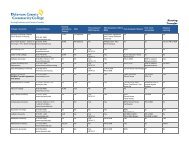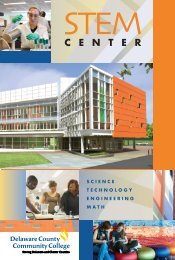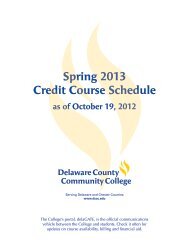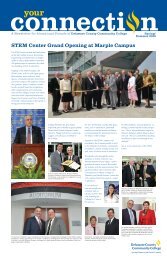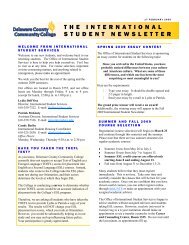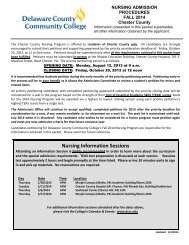2010 Catalog - Delaware County Community College
2010 Catalog - Delaware County Community College
2010 Catalog - Delaware County Community College
Create successful ePaper yourself
Turn your PDF publications into a flip-book with our unique Google optimized e-Paper software.
98 COURSE DESCRIPTIONS<br />
CPT 100<br />
(CPT) Carpentry<br />
Introduction to Carpentry<br />
Classroom instruction includes the proper use of<br />
measuring tools, applying blueprint interpretation and<br />
using mathematical skills needed for carpentry applications.<br />
Lab instruction includes proper use of hand and<br />
power tools, layout procedures, building materials<br />
application and rough framing. A review of basic math<br />
and measurement is covered at the onset of the course.<br />
Upon successful completion of this course, students<br />
should be able to:<br />
• Cite safety precautions for carpentry work.<br />
• Demonstrate hand and power tools associated with<br />
carpentry and their practical applications.<br />
• Select materials and supplies.<br />
• Utilize measurement tools correctly and accurately.<br />
• Building rough frame structures.<br />
• Read blueprints relevant to basic carpentry.<br />
4 Credits 3 Weekly Lecture Hours<br />
2 Weekly Laboratory Hours<br />
CPT 101<br />
Concepts of Carpentry Design<br />
Emphasis of this course is on carpentry skill components<br />
including: layout procedure, applications of measurement<br />
tools, blueprint reading, building codes and regulations,<br />
and applied mathematical formulas vital to the<br />
carpentry trade.<br />
Upon successful completion of this course, students<br />
should be able to:<br />
• Demonstrate the layout of foundations.<br />
• Perform rough framing projects.<br />
• Install rough floors.<br />
• Construct simple roof rafters.<br />
• Construct basic stairways.<br />
• Utilize carpentry blueprint-reading skills.<br />
• Perform mathematical equations pertinent to the<br />
skills required.<br />
Prereq. CPT 100<br />
4 Credits 3 Weekly Lecture Hours<br />
2 Weekly Laboratory Hours<br />
CPT 150<br />
Introduction to Cabinetmaking<br />
This course introduces basic cabinetmaking skills. Topics<br />
covered include material selection, layout, design, proper<br />
use and application of hand and power tools, and finishing<br />
techniques. Course includes the design and construction of<br />
various projects.<br />
Upon successful completion of this course, students<br />
should be able to:<br />
• Describe cabinet design considerations.<br />
• Make basic sketches and layouts.<br />
• Generate a Bill of Material for a project.<br />
• Identify woods by sight.<br />
• Discuss applications for woods.<br />
• List applications for each wood species.<br />
• Apply veneers.<br />
• Affix plastic laminates.<br />
• Select and apply different fasteners.<br />
• Use hand and power tools safely.<br />
• Make up various wood joints.<br />
• Fabricate fixtures.<br />
• Prepare a project for finishing.<br />
• Apply finishes to wood.<br />
2 Credits 1 Weekly Lecture Hours<br />
2 Weekly Laboratory Hours<br />
CPT 151<br />
Furniture Building<br />
This course presents the basic skills necessary to build<br />
furniture. Proper use of hand and power tools is covered.<br />
Wood joinery is covered along with different finishing<br />
techniques.<br />
Upon successful completion of this course, students<br />
should be able to:<br />
• Select wood for various applications.<br />
• Make basic joints including mortise, tenon and dovetails.<br />
• Demonstrate proper router applications.<br />
• Perform proper clamping techniques.<br />
• Apply finishes to achieve desired appearance.<br />
• Utilize shop tools safely.<br />
2 Credits 1 Weekly Lecture Hours<br />
2 Weekly Laboratory Hours<br />
CPT 152<br />
Home Remodeling/Additions<br />
Introduces basic principles of framing structures,<br />
insulation, paneling, ceramic tile for floors and walls, and<br />
basic carpentry skills. Topics covered include: stairs,<br />
roofing, basic plumbing and wiring, finishing work,<br />
skylights and windows and kitchens and bathrooms.<br />
Upon successful completion of this course, students<br />
should be able to:<br />
• Demonstrate proper applications of framing members<br />
including headers, beams, roof joist.<br />
• Lay out a stairway.<br />
• Apply ceramic tile with use of mastic or substrate.<br />
• Explain the basic concepts involved of home wiring.<br />
• Install a window into a new or existing opening.<br />
• Solder 1/2" and 3/4" copper tubing.<br />
• Construct a simple drainage branch using plastic pipe.<br />
2 Credits 1 Weekly Lecture Hours<br />
2 Weekly Laboratory Hours<br />
CPT 153<br />
Advanced Furniture Building<br />
This course is designed for students who are ready to<br />
progress beyond The Basics of Furniture Building (CPT<br />
151) course. It presents advanced techniques in wood<br />
bending using steam, laminate, freeform and coopering.<br />
The process of working with wood veneers and veneer<br />
inlays will be covered. Various methods in finishing and<br />
finishing materials will be emphasized.<br />
Upon successful completion of this course, students<br />
should be able to:<br />
• Select various types of wood for numerous application<br />
procedures<br />
• Build, setup and operate a steaming device for<br />
bending wood<br />
• Construct the appropriate form for bending procedures<br />
• Use wood laminates for the purpose of bending<br />
• Layout construction for coopering<br />
• Apply various techniques for staining and finishing<br />
2 Credits 1 Weekly Lecture Hours<br />
2 Weekly Laboratory Hours<br />
CPT 154 Introduction to Doors and<br />
Windows - Residential<br />
This course is designed to provide the student with the<br />
fundamentals of various phases of door and window<br />
construction, installation, and finishing. Classroom<br />
instruction includes the proper use of measuring tools,<br />
blueprint reading, math skills, and arranging materials<br />
needed for finish carpentry applications. Lab instruction<br />
includes layout procedures, the proper use of hand and<br />
power tools to cut and shape wood, plastic and fiberglass.<br />
Identification of door and window hardware will also be<br />
presented. Tools such as chisels, planes, saws, drills,<br />
sanders will be utilized.<br />
Upon successful completion of this course, students<br />
should be able to:<br />
• Describe and identify various parts of doors and windows.<br />
• Select the proper window and door sizes based on rough<br />
openings and manufacturers specifications.<br />
• Install windows on "New" house construction, replacement<br />
windows, and additional window placement.<br />
• Select various types of window glazing, glazing<br />
materials, and installing glass.<br />
• Discuss the identification and applications of interior and<br />
exterior door and window casings.<br />
• Construct and set door frames.<br />
• Identify and install door and window hardware.<br />
3 Credits 3 Weekly Lecture Hours<br />
CPT 160<br />
Introduction to Roofing and<br />
Siding<br />
This course provides an introduction to roofing and siding<br />
processes. The course is designed to provide instruction in<br />
the commonalties of theory and skills associated with the<br />
installation of low maintenance exterior building products<br />
to residential structures. Roofing and siding types,<br />
materials, measurements, exterior insulation, trim and<br />
soffits, and identification of flash valleys, sidewalls,<br />
chimneys, as well as roof obstructions will be discussed.<br />
The proper use of powered and non-powered hand tools<br />
will be covered thoroughly. Materials including roofing felt,<br />
organic and fiberglass asphalt shingles, aluminum and<br />
vinyl siding<br />
will be introduced.<br />
Upon successful completion of this course, students<br />
should be able to:<br />
• Define roofing and siding terms.<br />
• Describe and apply roofing felt, organic and/or fiberglass<br />
asphalt shingles and roll roofing.<br />
• Describe and apply aluminum and vinyl siding.<br />
• Identify flash valleys, sidewalls, chimneys, and other<br />
roof obstructions.<br />
• Cut and bend roll aluminum to fit exterior trim and soffits.<br />
• Apply and cut fanfold exterior insulation.<br />
• Estimate needed roofing and siding materials.<br />
4 Credits 2 Weekly Lecture Hours<br />
4 Weekly Laboratory Hours<br />
CPT 161<br />
Introduction to Staircase &<br />
Balconies<br />
This introductory course is designed to provide the student<br />
with a concentrated instruction method in staircases and<br />
balconies. The student will learn basic concepts which<br />
includes, stairway and balcony types, layouts, construction<br />
and terminology. Design concepts, platforms and landings,<br />
spiral staircases and balcony construction will be thoroughly<br />
presented. In addition, mathematical calculations will be<br />
used to determine proper tread rise and various carpentry<br />
measurements.<br />
Upon successful completion of this course, students<br />
should be able to:<br />
• Identify various types of staircases and balconies and<br />
their terminology.<br />
• Perform mathematical calculations to determine proper<br />
tread rise and run of a given staircase.<br />
• Layout and fabricate plain, square cut, mitered and<br />
housed stringers and stair horses.<br />
• Layout and fabricate platforms and landings.<br />
• Construct and install balusters, newels, and handrails.<br />
• Fabricate and install balcony skirts.<br />
• Utilize existing building codes to comply with code<br />
enforcement regulations<br />
4 Credits 2 Weekly Lecture Hours<br />
4 Weekly Laboratory Hours<br />
CPT 162 Introduction to Interior Trim,<br />
Walls and Ceilings<br />
This course is designed to introduce the student to the<br />
field of interior trim carpentry. The course presents the<br />
basic phases of drywall construction, ceiling applications,<br />
and interior trim processes. Topics covered include layout<br />
procedures, proper use of tape, corner beads, and drywall<br />
joint compound. In addition, ceiling construction, suspended<br />
ceilings, and ceiling tile trim will be presented. The process<br />
of measuring proper applications of moldings, and<br />
molding patterns will be covered.<br />
DELAWARE COUNTY COMMUNITY COLLEGE




